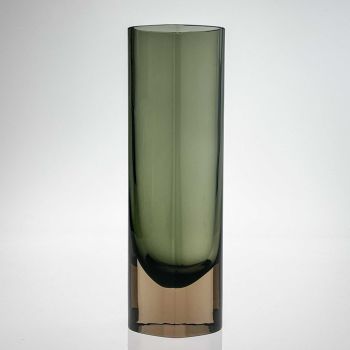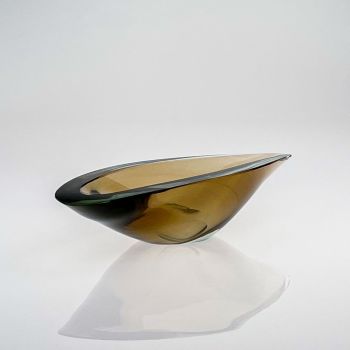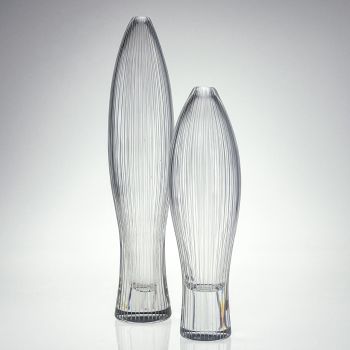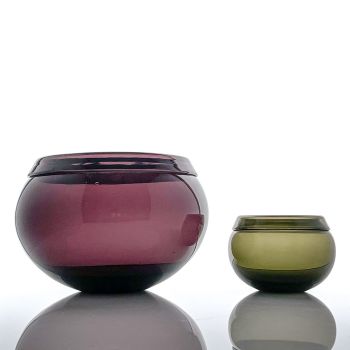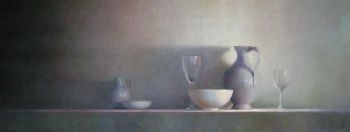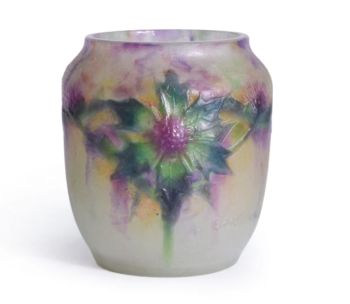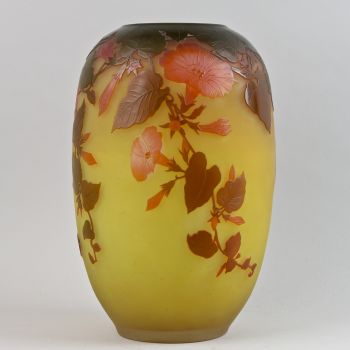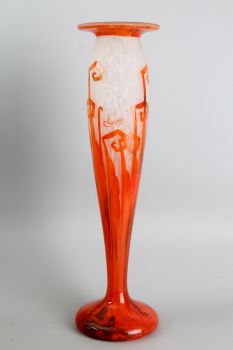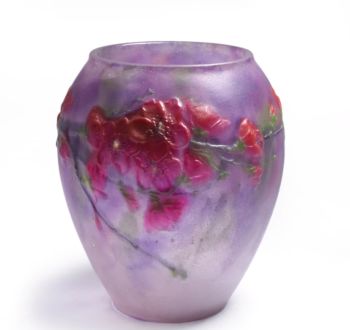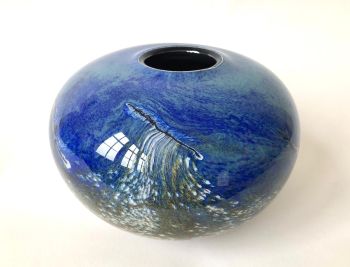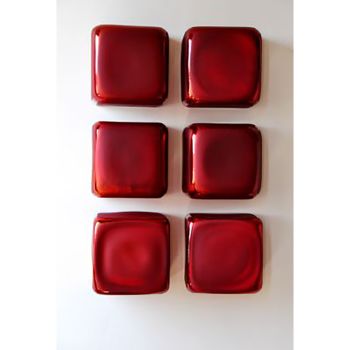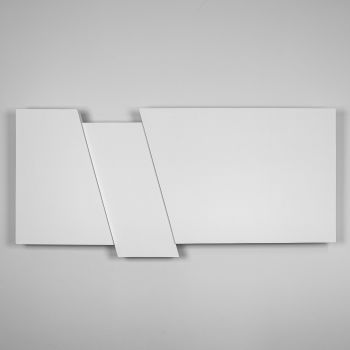A blue and clear glass Art-Object “Lansetti” (Lancet), Model KF219 – Nuutajärvi-Notsjö, Finland 1957 1957
Kaj Franck
Copo
3 ⨯ 32 ⨯ 9 cm
ConditionVery good
€ 1.650
Van Kerkhoff Art
- Sobre arteA free blown and cut and polished blue and clear cased artglass object “Lansetti” (Lancet), model KF219. Designed by Kaj Franck in 1954, it was skillfully brought to life by the artisans of the Nuutajärvi-Notsjö glassworks in 1957.
These coveted objects, produced between 1954 and 1961 in two different sizes and several colour combinations. This particular example is an early smaller sized “Lancet”, featuring a delicate interplay of blue and clear glass. It is worth mentioning that Franck also designed a more curved variant of the “Lancet,” known as model KF218, which is a better-known model.
This artglass object, a testament to its age, bears the gentle marks of its vintage journey. In good condition, it retains its inherent charm. The base proudly carries the fully signed and dated inscription: K. Franck Nuutajärvi-Notsjö ’57.
About Kaj Franck
Kaj Franck (Vyborg, Finland 1911 – Santorini, Greece 1989), a pioneering Finnish designer and a prominent figure in the Finnish art world from 1940 to 1980, left an indelible mark on the design landscape. Today, his name is synonymous with excellence and innovation, as exemplified by the prestigious “The Kaj Franck Design Prize,” which is annually awarded by the esteemed Finnish Design Forum.
Born in 1911 on the Finnish-Russian border into a family with a rich architectural heritage, Franck had design in his blood. His grandfather held a prominent position as the director of the renowned Arabia Ceramics factory, underscoring the influence and inspiration that surrounded him from an early age.
Franck pursued his passion for design by studying at the furniture department of Taideteollinen korkeakoulu, known today as the Aalto University School of Arts, Design, and Architecture, in Helsinki. Equipped with a solid foundation in design principles, he embarked on a career as a freelance designer before joining Arabia in 1945. It was during his time at Arabia that Franck’s talent truly flourished, and in 1950, he assumed the role of the company’s Artistic Director.
While his contributions to Arabia were significant, Franck’s creative vision extended beyond ceramics. He also designed glass objects for Iittala between 1946 and 1950, and later for Nuutajärvi-Notsjö glassworks from 1950 to 1976. His designs, particularly in everyday tableware and glassware, propelled him to the forefront of the design world. Notably, his iconic Kilta tableware and Kartio glassware are celebrated as revolutionary and enduring symbols of classic Finnish design.
Franck’s design philosophy embodied a profound commitment to principles of moderation, ecology, and equality. Often referred to as “the conscience of Finnish design,” he advocated for minimalism and the conscious reduction of everyday objects, emphasizing the importance of sustainability and product life cycles. Franck’s designs were a testament to his belief that beauty and functionality could coexist harmoniously, enhancing the lives of individuals while respecting the environment.
Recognized for his exceptional contributions, Franck’s works grace the collections of esteemed museums worldwide. Noteworthy institutions such as the Design Museum Helsinki, the Museum of Modern Art in New York, the Stedelijk Museum Amsterdam, and The British Museum in London all proudly display his creations. Throughout his illustrious career, Franck received numerous accolades, including the prestigious Lunning Prize in 1955, as well as “Grand Prix” and multiple “Gold Medals” at the renowned Triennale di Milano.
Kaj Franck’s enduring legacy rests not only on his remarkable designs but also on his unwavering commitment to advancing the field of design. His vision, which emphasized sustainability, simplicity, and social consciousness, continues to inspire designers and enthusiasts alike, ensuring that his influence will be felt for generations to come.
Marked
signed underneath the base in diamondpen: K. Franck Nuutajärvi-Notsjö ’57 (1957)
Condition
This art-object is in good vintage condition, some minor scratches and wear consistent with age and use. No chips or cracks.
Literature
Marianne Aav (ed.), Kaj Franck, Universal Forms, p.323
Dimensions
Height 3,5 cm
Width 32,6 cm
Depth 9,6 cm
Weight 837 grams - Sobre artista
O designer finlandês de cerâmica e vidro Kaj Franck (1911-1989) percebeu uma verdade poderosa em sua distinta carreira: simples é belo. Apesar do mundo se mover em um ritmo cada vez mais rápido, de uma década para outra, essa simples verdade permanece. A inspiração e os princípios de Franck deram início a uma tradição no design finlandês, que ainda hoje está viva e forte. Seus trabalhos mais conhecidos são as séries Iittala Teema e Kartio, e sua herança faz parte de todos os lares finlandeses.
"Eu quero fazer uso de objetos que são tão óbvios que não são perceptíveis", Kaj Franck definiu seu próprio trabalho. Seus projetos atendiam às necessidades humanas básicas, servindo-lhes ferramentas com propriedades de objetos do cotidiano. produção em massa de custo e materialismo evitado, cultura descartável e ostentação. O mundo de Franck consistia em formas matemáticas básicas e formas simples, decoradas apenas com cores fortes.
O ponto de partida do trabalho de Franck foi a praticidade aliada à beleza. Embora pareça evidente hoje, em seu próprio tempo seus pensamentos eram radicais. Franck separou os estilos e as tendências da moda da tradição e deu-lhes um novo significado. No período de 1952-53, Franck mostrou que a louça não precisa ser excessivamente complexa com o lançamento da série Kilta como uma afirmação forte - era uma ideia inovadora que todos pudessem fazer os arranjos de mesa de acordo com suas próprias necessidades .
Franck começou seus projetos concentrando-se na ideia ou conceito subjacente, não na forma. Essa ênfase no aspecto da ideia do design também foi levada ao seu trabalho como professor e, posteriormente, como diretor artístico na Universidade de Arte e Design em Helsinque. Franck também foi um dos primeiros defensores da reciclagem e muitas vezes foi chamado de "consciência do design finlandês". Franck ganhou muitos prêmios em sua distinta carreira e tornou-se internacionalmente famoso. Hoje, o Kaj Franck Award é o reconhecimento de design de maior prestígio da Finlândia .
Você está interessado em comprar esta obra de arte?
Artwork details
Related artworks
- 1 - 4 / 9
Børge Mogensen
Teak wood “dropleaf” desk – Søborg Møbler, Denmark circa 19551950 - 1960
Preço em pedidoVan Kerkhoff Art
1 - 4 / 24Frères Daum
Daum Nancy – “Paysage Soleil Couchant” vase with two applied handles1900 - 1910
Preço em pedidoAntiques Emporium
1 - 4 / 24- 1 - 4 / 24
Johann Loetz (Lötz) Witwe Klostermühle
Johann Loetz Witwe - Phänomen Genre 7773 – Orange1900 - 1910
Preço em pedidoAntiques Emporium
1 - 4 / 24- 1 - 4 / 12














